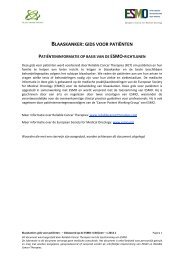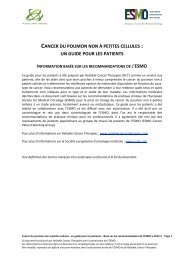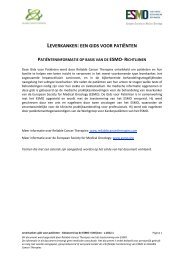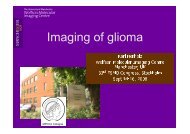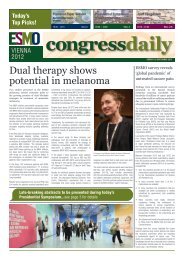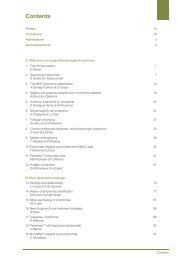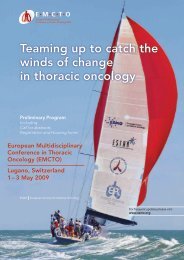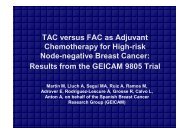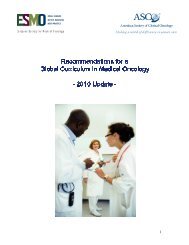Bladder cancer - European Society for Medical Oncology
Bladder cancer - European Society for Medical Oncology
Bladder cancer - European Society for Medical Oncology
You also want an ePaper? Increase the reach of your titles
YUMPU automatically turns print PDFs into web optimized ePapers that Google loves.
WHAT CAUSES BLADDER CANCER?<br />
Today, it is not entirely clear what causes bladder <strong>cancer</strong>. A number of risk factors* have been<br />
identified, but in many cases none of these seem to be present. A risk factor increases the risk that<br />
the <strong>cancer</strong> occurs, but is neither necessary nor sufficient to cause <strong>cancer</strong>. A risk factor is not a cause<br />
in itself.<br />
Some people with these risk factors will never develop bladder <strong>cancer</strong> and some people without<br />
any of these risk factors may nonetheless develop bladder <strong>cancer</strong>.<br />
The main risk factors <strong>for</strong> bladder <strong>cancer</strong> are:<br />
‐ Aging: bladder <strong>cancer</strong> occurs most frequently in elderly people; overall,<br />
70% of patients developing bladder <strong>cancer</strong> are diagnosed after the age of<br />
65 years.<br />
‐ Previous history of bladder <strong>cancer</strong>.<br />
‐ Cigarette smoking: cigarette smoking is the most important risk factor <strong>for</strong><br />
bladder <strong>cancer</strong>. Stopping cigarette smoking <strong>for</strong> more than 4 years can<br />
lower the risk.<br />
‐ A number of chemicals have been identified that may cause bladder <strong>cancer</strong>:<br />
o Aniline dyes: chemicals that may be present in color fabrics.<br />
o Cyclophosphamide: a chemotherapeutic* drug used <strong>for</strong> <strong>cancer</strong> treatment.<br />
o Aromatic amines: exposure to these chemicals can occur in various occupations such<br />
as those in the painting, leather, car, metal, paper and rubber industry, but also<br />
amongst truck drivers, dry cleaners, dental technicians and hairdressers. In these<br />
circumstances, bladder <strong>cancer</strong> does not occur until 30 to 50 years after exposure.<br />
o Arsenic: in a Taiwanese region where water contained high arsenic levels, an<br />
increased risk of bladder <strong>cancer</strong> has been found.<br />
o Aristolochia fangchi: this is a Chinese herb; an increased risk of bladder <strong>cancer</strong> was<br />
found in people that had used a dietary supplement in which this herb had been<br />
mistakenly added.<br />
‐ Irradiation: exposure to ionizing irradiation* in the region of the bladder, <strong>for</strong> example during<br />
radiotherapy <strong>for</strong> prostate* <strong>cancer</strong>, is thought to increase the risk of bladder <strong>cancer</strong>.<br />
‐ Some risk factors are particularly important <strong>for</strong> a specific type of bladder <strong>cancer</strong>, namely<br />
squamous cell carcinoma*. This tumor is caused by chronic irritation or inflammation of the<br />
bladder. In Western countries, the main risk factors <strong>for</strong> squamous cell carcinoma include a<br />
badly‐functioning bladder, prolonged presence of a catheter* in the bladder, bladder stones<br />
and chronic bladder infection. In Africa and the Middle East, an important risk factor <strong>for</strong><br />
squamous cell carcinoma is infection with Schistosoma hematobium, a microbe that is<br />
common in these regions. It can infect the bladder and lead to chronic inflammation.<br />
‐ Diabetes*: individuals with type‐2 diabetes are at an increased risk of developing bladder<br />
<strong>cancer</strong>.<br />
<strong>Bladder</strong> <strong>cancer</strong>: a guide <strong>for</strong> patients‐ In<strong>for</strong>mation based on ESMO Clinical Practice Guidelines ‐v.2012.1 Page 5<br />
This document is provided by Reliable Cancer Therapies with the permission of ESMO.<br />
The in<strong>for</strong>mation in this document does not replace a medical consultation. It is <strong>for</strong> personal use only and cannot be modified,<br />
reproduced or disseminated in any way without written permission from ESMO and Reliable Cancer Therapies.





